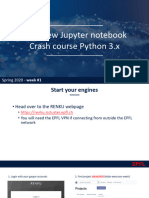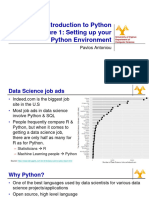0 ratings0% found this document useful (0 votes)
10 viewsIntro Python
Uploaded by
fajrinCopyright
© © All Rights Reserved
We take content rights seriously. If you suspect this is your content, claim it here.
Available Formats
Download as PDF, TXT or read online on Scribd
0 ratings0% found this document useful (0 votes)
10 viewsIntro Python
Uploaded by
fajrinCopyright
© © All Rights Reserved
We take content rights seriously. If you suspect this is your content, claim it here.
Available Formats
Download as PDF, TXT or read online on Scribd
You are on page 1/ 11
A brief and biased introduction to
python
Ch. Morisset, IA-UNAM
History
●
1991 : Guido van Rossum started to worked on
Python
●
1996 : Numerical python, precursor of Numpy.
●
2003 : Matplotlib, MATLAB-like interface.
How to get python ?
●
Most of the OS have some python installed, but
not the scientific libraries.
●
The best is to use a package that includes
everything you need (and more…).
●
Anaconda is one of them. It includes the former
STSCI Ureka project, pyRAF is an option.
●
It leaves in a single directory, easy to remove.
Which python version ?
●
There are 2 main versions of python currently
used :
– Python 2 : 2.7 latest subversion, maintained till 2020
– Python 3 : 3.6 most recent.
●
PB : no backward compatibility…
●
Main painful difference : strings.
●
Best to learn python 3, all the major libraries are
py3-compliant.
Multiple versions of python
●
Using conda, one can create different
« environments » : each one being a full python
installation.
●
Creation of a new environment :
– conda create --name py3k python=3 astropy
●
Switching is as easy as (from bash only) :
– source activate py3k
Growing python
●
The amount of libraries is huge.
– Anaconda installing facility:
● conda install astropy
– Pip installing facility (from PyPI - the Python
Package Index) :
● pip install pyneb
– From github (e.g. devel version):
● pip install -U git+https://github.com/Morisset/PyNeb_devel.git
Running python
●
Interactive : ipython
– Completion
– History
– Magic commands
●
Running scripts
– %run test # executing test.py
– import library
– test.py ; from Linux prompt
Notebooks
●
Esthetic way of gathering script and results,
including tables and figures.
●
Executable
●
Python lectures, PyNeb manual, pyCloudy
sample scripts and Cloudy School examples.
●
https://github.com/Morisset/Python-lectures-Notebooks
Indispensable libraries
●
Numpy : vectorisation
●
Matplotlib : plotting facilities
●
Scipy : scientific tools
●
Astropy : astronomical tools
●
Pandas : tables
Object Oriented Programing
●
Very powerful way of programing.
●
Object = smart container with variables (attributes)
and functions (methods)
●
Class definition and object instantiations.
●
All objects of the same class share the same
methods and properties, but can have different
values for the attributes.
●
As many objects from the same class as one want.
Help
●
The python community is very active.
●
Somebody already had your problem, and
somebody already solved it ; just find the words
to describe it
●
StackOverflow is THE site where to look for a
solution.
You might also like
- Introduction To Python 3: Chang Y. ChungNo ratings yetIntroduction To Python 3: Chang Y. Chung25 pages
- Intro To Scientific Python (2018-01-23) PDFNo ratings yetIntro To Scientific Python (2018-01-23) PDF16 pages
- An Introduction To The Python Programming Language: Prabhu RamachandranNo ratings yetAn Introduction To The Python Programming Language: Prabhu Ramachandran88 pages
- Introduction To Python Lecture 1: Setting Up Your Python EnvironmentNo ratings yetIntroduction To Python Lecture 1: Setting Up Your Python Environment33 pages
- A Crash Course in Python For Scientists PDFNo ratings yetA Crash Course in Python For Scientists PDF55 pages
- An Introduction To Python For Scientific Computing: © 2019 M. Scott Shell Last Modified 9/24/2019No ratings yetAn Introduction To Python For Scientific Computing: © 2019 M. Scott Shell Last Modified 9/24/201962 pages
- Lesson 03 Programming Environment SetupNo ratings yetLesson 03 Programming Environment Setup33 pages
- Python Tools for Scientists An Introduction to Using Anaconda JupyterLab and Python s Scientific Libraries 1st Edition Lee Vaughan instant download100% (2)Python Tools for Scientists An Introduction to Using Anaconda JupyterLab and Python s Scientific Libraries 1st Edition Lee Vaughan instant download40 pages
- Python Programming For Economics FinanceNo ratings yetPython Programming For Economics Finance267 pages
- Python Programming For Economics FinanceNo ratings yetPython Programming For Economics Finance267 pages
- Class 1 Methods: From Import Import As Import Import From Import Import As Import AsNo ratings yetClass 1 Methods: From Import Import As Import Import From Import Import As Import As43 pages
- Python and Matplotlib Essentials For Scientists and Engineers-Morgan & Claypool (2015)No ratings yetPython and Matplotlib Essentials For Scientists and Engineers-Morgan & Claypool (2015)205 pages
- Python Programming: Start Your Python Scripts in PycharmNo ratings yetPython Programming: Start Your Python Scripts in Pycharm24 pages
- Introduction - IPython Interactive Computing and Visualization Cookbook - INTRODUCTIONNo ratings yetIntroduction - IPython Interactive Computing and Visualization Cookbook - INTRODUCTION7 pages
- Mastering Python Programming: A Comprehensive Guide: The IT CollectionFrom EverandMastering Python Programming: A Comprehensive Guide: The IT Collection5/5 (1)
- VMAX All Flash Fundamentals Cource DescriptionNo ratings yetVMAX All Flash Fundamentals Cource Description2 pages
- Ascione et al_2014_Acoustic evaluation of the cathedral of Seville as a concert hall and proposalsNo ratings yetAscione et al_2014_Acoustic evaluation of the cathedral of Seville as a concert hall and proposals20 pages
- Femtocells: Presented By: Sonam Aggarwal MT2310207No ratings yetFemtocells: Presented By: Sonam Aggarwal MT231020720 pages
- Are You Under A DoS or DDoS Attack - Find Out With Netstat !No ratings yetAre You Under A DoS or DDoS Attack - Find Out With Netstat !4 pages
- FHWA Bridge Geometry Manual-2022 Dot - 62673 - DS1No ratings yetFHWA Bridge Geometry Manual-2022 Dot - 62673 - DS1236 pages
- Powerbuilder Enterprise: Installation GuideNo ratings yetPowerbuilder Enterprise: Installation Guide42 pages
- Building Inspection Report Form: Source Of: C. HCB: D. Steel Rebar: E. Struct. Timber: ..No ratings yetBuilding Inspection Report Form: Source Of: C. HCB: D. Steel Rebar: E. Struct. Timber: ..3 pages





























































































